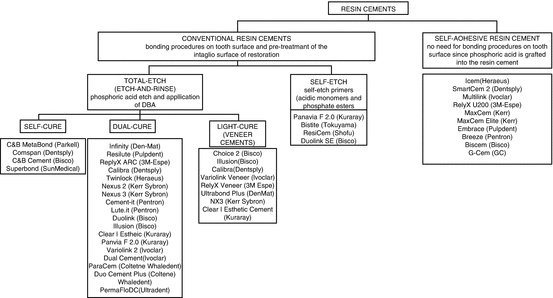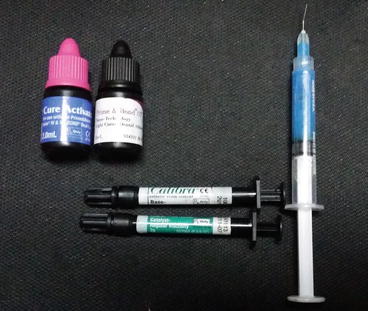and Armin Segarra1
(1)
University of the Philippines Manila College of Dentistry, Paranaque, Philippines
3.1 Introduction
Resin cements are the newest types of cements used to lute and bond indirect restorations. They have higher compressive, tensile, and flexural strength and wear resistance compared to the conventional luting cements. They come in different shades and are virtually insoluble in oral fluids providing better marginal seal than any other cement types. These categories of cements can be used for all types of restorative materials (porcelain, metal, porcelain fused to metal, laboratory composites).
Resin cements should bond both to the tooth structure and the internal surface of the restoration. In the previous chapter, the bonding mechanism of the resin cement to the internal surface of the restoration was discussed in detail. This chapter focuses mainly on the adhesion of the resin cement to the tooth surface.
In current clinical practice, there are three available resin cements in the market classified according to their adhesive characteristics. These are the etch-and-rinse resin cements, also called total-etch cements, the self-etch resin cements, and the self-adhesive resin cements (Fig. 3.1). Numerous terminologies pertaining to these three types of cements can be found in books and journals, which add to the confusion in classification. Some authors call the etch-and-rinse cements and self-etch cements conventional resin cements (CR cements) as they require adhesive pretreatment of the tooth surface, i.e., etching, priming, and bonding. The self-adhesive resin cements are sometimes referred to as simply adhesive resin cements (AR) or true adhesive cements as they can bond to the tooth surface on their own without the need for prior etching and bonding.


Fig. 3.1
Classification of resin cements and some representative brands
Generally, the etch and rinse resin cements yield the highest bond strengths to enamel, while self-etch resin cements show higher bond strengths to dentin. Self-adhesive resin cements have lower bond strengths than the total etch and self-etch resin cements (Sanvin and de Rijk 2006).
3.2 The Etch-and-Rinse Cements (Total-Etch Cements)
3.2.1 Description
These cements are those that use etch-and-rinse or total-etch adhesives. The enamel and dentin surface is etched with 36–37 % phosphoric acid followed by an application of a single layer of the single-bottle self-priming adhesive (dentin-bonding agent or DBA) prior to cementation with the resin cement. These cements, depending on the brand, can be self-cured, dual cured, or light cured. The veneer cements are included in this category.
3.2.2 Technical and Clinical Considerations
Since etch-and-rinse cements involve etching the enamel and dentin with phosphoric acid, they yield the highest bond strengths to the enamel among all resin cements. When used properly, they yield high bond strengths to dentin (Casseli and Martins 2006). Like all resins which bond using etch-and-rinse adhesives, however, these cements require the most number of steps and are more technique sensitive than the other types of resin cements (Burgess et al. 2010). The clinical success of these cements is greatly affected by operator factors. Tooth isolation is of paramount importance with these cements. Some recommend that they be best used for easy to isolate areas in the mouth, the anterior segment (ADA Expert Panel 2006). Another concern with this type of cement is postoperative sensitivity that occurs if the opened dentinal tubules from acid etching are not well sealed (Christensen 2007). Additionally, dentin is less calcified than the enamel, and prolonged phosphoric acid etching can lead to decrease in bond strengths. When using these cements, therefore, care should be taken not to etch the dentin for more than 20 s to prevent postoperative sensitivity. There is also concern about the incompatibilities between the acidic dentin-bonding agent used in conjunction with these cements and the amine initiators of some self- and dual-cured cements in this category. Some authors recommend the additional application of a self-cured activator over the adhesive layer prior to cementation to avoid such incompatibilities (King et al. 2005).
In summary, the keys to successful cementation and preventing postoperative sensitivity with etch-and-rinse resin cements are as follows:
1.
Do not overdry the tooth, especially after etching. The surface should appear glossy.
2.
Limit etching time to 15 s only on dentin.
3.
Ensure adequate sealing of the dentinal tubules through proper application of the dentin-bonding agent.
4.
Ensure proper tooth isolation, preferably with a rubber dam.
5.
When using self- or dual-cured resin cement, use a self-cured activator to prevent incompatibilities between the amine initiator of the cement and the acidic DBA.
3.2.3 Indications
Factoring in all the advantages and disadvantages of resin cements (Table 3.1), these cements are recommended for the following:
Table 3.1
Advantages and disadvantages of etch-and-rinse resin cements
|
Advantages
|
Disadvantages
|
|---|---|
|
Higher bond strengths to the enamel and other highly calcified tooth structures (sclerotic dentin, fluorosed enamel, etc.)
|
Multistep
|
|
High bond strength to dentin if used properly, strict attention to details
|
Technique sensitive
|
|
Usually come in many shades—good shade matching
|
Possibility of postoperative sensitivity if not used properly on dentin surfaces
|
1.
Restorations where the predominant tooth structure present is the enamel such as in the case of veneers.
2.
Preparations on highly calcified tooth structures (fluorosis, sclerotic dentin, arrested dentin).
3.
Enamel margins of inlays and onlays (using the selective etch technique). The selective etch technique involves etching with phosphoric acid the enamel margins only for 20 s. The etchant is then washed off and the tooth dried, and a self-etch adhesive is then applied on both the enamel and dentin.
4.
Cementation of low-strength ceramics (feldspathic porcelains) as high bond strengths can strengthen the low-strength ceramic.
5.
Maryland bridges.
3.2.4 Manipulation
Total-etch resin cements either come in two-paste systems or paste-powder systems and with their corresponding etchant and single-bottle dentin-bonding agents. A self-cured activator is also included with the kit. The dual-cured activator serves as a barrier between the acidic single-bottle DBA and the amines of the dual-cured or self-cured resin cement. The porcelain etchant (HF acid) and silane used for pretreatment of the ceramics and laboratory composites are sold separately (Fig. 3.2).
Stay updated, free dental videos. Join our Telegram channel

VIDEdental - Online dental courses



